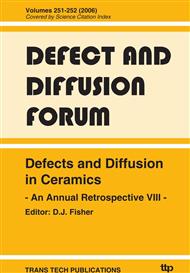p.51
p.59
p.69
p.79
p.89
p.97
p.105
p.111
p.123
Phenomenological Model for Creep Behaviour in Cu-8.5at%Al Alloy
Abstract:
Creep experiments were conducted on Cu-8.5at.% Al alloy in the intermediate temperature range from 673 to 873K, corresponding to 0.46-0.72 Tm where Tm is the absolute melting temperature. The present analysis reveals the presence of two distinct deformation regions (climb and viscous glide) in the plot of log ε vs. log σ. The implications of these results on the transition from powerlaw to exponential creep regime are examined. The results indicated that the rate controlling mechanism for creep is the obstacle-controlled dislocation glide. A phenomenological model is proposed which assumes that cell boundaries with sub-grains act as sources and obstacles to gliding dislocations.
Info:
Periodical:
Pages:
89-96
Citation:
Online since:
March 2006
Authors:
Price:
Сopyright:
© 2006 Trans Tech Publications Ltd. All Rights Reserved
Share:
Citation:


